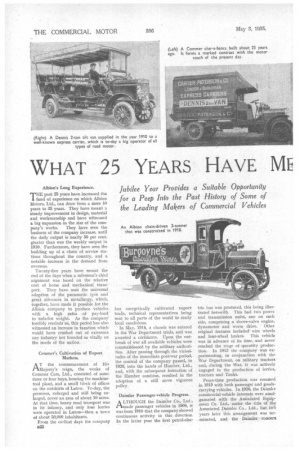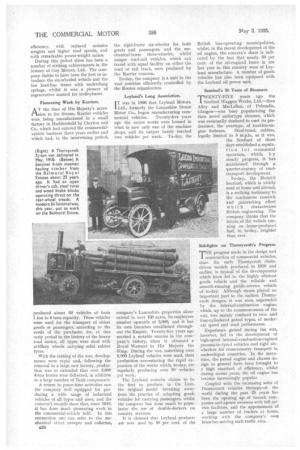WHAT 25 YEARS HAVE ME
Page 36

Page 37

Page 38

If you've noticed an error in this article please click here to report it so we can fix it.
AiNT TO MAKERS
Albion's Long Experience.
THE past25 years have increased the fund of experience on which Albion Motors, Ltd., can draw from a mere 10 years to 35 years. They have meant a steady improvement in design, material and worhmanship and have witnessed a big expansion in the size of the com
pany's works. They have seen the business of the company increase, until the daily output is nearly 50 per cent. greater than was the weekly output in 1910. Furthermore, they have seen the building up of a chain of service stations throughout the country, and a notable increase in the demand from overseas.
Twenty-five years have meant the end of the days when a salesman's chief argument was based on the relative cost of horse and mechanical transport. They have seen the universal• adoption of the pneumatic tyre and great a:dvanees in metallurgy, which, together, have made it possible for the Albion company to produce vehicles with a. high ratio of pay-load to unladen weight. As the company• forcibly reminds us, this period has also witnessed an increase in taxation which wotild have crushed out of existence any industry not founded so vitally on the needs of the nation.
Commer's Cultivation of Export Markets.
A T the commencement of His
iMajesty's reign, the works of Commer Cars, Ltd., consisted of some three or four bays, housing the machinetool plant, and a small block of offices on the ontskirts of Luton. To-day, the premises, enlarged and still being enlarged, cover an area of about 10 acres. At that time, heavy road transport was in its infancy, and only four lorries were operated in Luton—then a town of about 50,000 inhabitants.
From the earliest days the company B22 has energetically cultivated export trade, technical representatives being sent to all parts of the world to study local conditions.
In May, 1914, a chassis was entered in the War Department trials, and was awarded a certificate. Upon the outbreak of war all available vehicles were commandeered by the military authorities. After passing through the vicissitudes of the immediate post-war period, the control Of the company passed, in 1926; into the hands of Humber, Ltd., and, with the subsequent formation of the Humber combine, resulted in the adoption of a still more vigorous policy.
Daimler Passenger-vehicle Progress.
A LTHOUGH the Daimler Co., Ltd., 4—Vmade passenger vehicles in 1908, it was from 1910 that the company showed continuous activity in this direction. In the latter year the first petrol-elec
tric bus was produced, this being illustrated herewith. This had two power and transmission units, one on each side, comprising a sleeve-valve engine, dynamotor and worm drive. • Other original features included' wire wheels and four-wheel brakes. This vehicle was in advance of its time, and never reached the 'stage of quantity production. In 1913 the company was experimenting, in conjunction with the War Department, on military tractors and, during the War, it was actively engaged in the production of lorries, tractors and Tanks.
Peace-time production was resumed In 1919 with both passenger and goodscarrying vehicles. In 1926, the Daimler 'commercial-vehicle interests were amalgamated with the Associated Equipment Co. Ltd., under the title of the Associated Daimler Co., Ltd.; but two years later this arrangement was terminated, and the Daimler concern resumed production at Coventry, making only passenger vehicles. The most notable achievement in Daimler bus design since 1928 was the introduction of the Fluid Flywheel transmission in 1930.
Unbroken Prosperity, of Dennis Content'.
I N 1910, Dennis Brothers, Ltd., of Guildford, was already in its 15th year. Its chassis were being built at the Onslow Street works, in the centre of the town, the entire staff numbering about 300, 'whilst bodies were constructed in a large shop outside the town, and this ultimately became the nucleus of the present extensive factory. In 1910, artillery-type wheels gave place to cast-steel wheels and, about this time, the first of the turbinetype fire-engines made its appearance. The manufacture of private cars ceased in 1912.
The output of the factory—already much enlarged—was, in 1914, commandeered for national service, 7,000 Dennis vehicles being taken over by the War Department, in addition to a large number of pumping units. In 1925, the first pneumatic-tyred bus was passed for London service—a Dennis— whilst, in the following year, a Dennis was, the company says, the first fourwheeled-braked bus to be passed for service in the Metropolis. In recent months the company has introduced a low-pressure oil engine. In 1928, the Dennis concern received a warrant of appointment to His Majesty the King. The 'pay roll of the company pow carries 1,500 names.
On the financial side, the record is one of unbroken prosperity—never has the dividend failed the shareholders.
Foden's Pass from Steam to Oil.
I N the opinion of Fodens, Ltd., no industry has progressed with such rapid strides in the past 25 years as the commercial-vehicle trade. The trials instituted by''the War Department in 1901, to determine the reliability of steam wagons, in which the Foden gave a good account of itself, was the first milestone in the company's success, and started an era of profitable trading. From 1914 to 1918, Foden steam wagons gave good service in transporting army supplies in France. Further developments were made in 1922, when Ackermann steering was adopted, together with an improved form of control, a higher road speed and a capacity for a greater load.
The company was quick to realize the possibilities of the compressionignition unit and, in 1931, sold its first oil-engined rnodel. Since that. time, numbers of such vehicles, with capacities ranging from 2 tons to 14 tons, have been built.
In 1933, the company's first passenger vehicle was produced, whilst the latest model in this field is the Aerstreme coach, in the design of which streamlining is adopted to marked effect.
Highlights in Guy's History.
IT is 21 years sihce the Guy vehicle, shown in an accompanying illustration, was produced, and, even to those
who have been engaged in the industry since that time, the progress that has been made in the design and manufacture of commercial vehicles is remarkable. The advent of high-grade alloy steels, die castings, metal pressings and attractive designs of all-metal and coachbuilt bodywork, has resulted in the introduction of vehicles of greater efficiency, with reduced unladen weights and higher road speeds, and with remarkable power-weight ratios.
During this period there has been a number of striking achievements in the history of Guy Motors, Ltd. The company claims to have been the first to introduce the six-wheeled vehicle and the low load-line frame with underslung springs, whilst it was a pioneer of regenerative control for trolleybuses.
Pioneering Work by Karriers.
AT the time of His Majesty's accession to the throne, Karrier vehicles were being manufactured in a small factory in Huddersfield by Clayton and Co., which had entered the commercialvehicle business three years earlier and which had, in the intervening period,
produced about 60 vehicles of born 1 ton to 4 tons capacity. These vehicles were used for the transport of either goods or passengers, according to the needs of the purchaser, for, at this early period in the history of the heavy road motor, all types were shod with artillery wheels carrying solid rubber tyres.
With the coming of the war, developments were rapid and, following the removal to a large new factory, production was so extended that over 2,000 4-ton lorries were delivered, in addition to a large number of Tank components.
A return to peace-time activities saw the company well equipped for producing a wide range of industrial vehicles of all types and sizes, and the concern's records show that, since 1918, it has done much pioneering work in the commercial-vehicle field.. In this connection one can refer to the mechanical street sweeper and collector, B24 the rigid-frame six-wheeler for both goods and passengers, and the mechanical-horse three-wheeler, whilst unique road-rail vehicles, which can travel with equal facility on either the road or rail track, were produced by the Karrier concern.
To-day, the company is a unit in the vast combine efficiently controlled by the Rootes organization.
Leyland's Long Association.
IT was in 1896 that Leyland Motors, Ltd., formerly the Lancashire Steam Motor Co., began manufacturing com
mercial vehicles. Twenty-five years ago the entire works were housed in what is now only one of the machine shops, and its output barely reached two vehicles per week. To-day, the company's Lancashire properties alone extend to over 160 acres, its employees number upwards of 5,000, and it has its own branches established throughout the Empire. Twenty-five years ago marked a notable success in the company's history, when it obtained a Royal Warrant to His Majesty the -King. During the war, something over 6,000 Leyland vehicles were used, their production necessitating the rapid expansion of the works which, to-day, are regularly producing over 50 vehicles per week.
The Leyland concern claims to he the first to produce, in the Lion, the original model breaking away from the practice of adapting goods vehicles for carrying passengers, whilst the company has (lone much to popularize the use of double-deckers on country services.
It is claimed that Leyland products are now used by 68 per cent. of the
British bus-operating. municipalities, whilst, in the recent development of the oil engine, the concern's share is indicated by the fact that nearly 50 per cent. of the oil-engined buses in use last year in this country were of Leyland manufacture. A number of goods vehicles has also been equipped with the Leyland oil power unit.
Sentinel's 25 Years of Steamers.
TRVENTY-FIVE years ago the 1 Sentinel Waggon Works, Ltd.—then Alley and MacLellan, of Polmadie, Glasgow—was busy popularizing the then novel undertype steamer, which was eventually destined to oust its predecessor, the overtype, of traction-en gine forbears. Steel-tyred, cabless, legally limited to 5 m.p.h., as it was, the Sentinel of those days established a reputation for economical operation, which, b y steady progress, it has maintained through a quarter-century of roadtransport development
To-day, the Model-S Sentinel, which is widely used at home and abroad, is a striking testimony to the continuous research and painstaking effort w hich characterizes British engineering. The company thinks that the future of the vehicle running on home-produced fuel, is, to-day, brighter than ever.
Sidelights on Thornycroft's Progress.
THE progress made in the design and 1 construction of commercial vehicles, since the early Thornycroft chaindriven models produced in 1910 and earlier, is typical of the developments which have led to the highly efficient • goods vehicle and the reliable and smooth-running public-service vehicle of to-day. Although steam played an important part in the earliest Thornycroft designs, it was soon superseded by the internal-combustion engine, which, up to the commencement of the war, was mainly confined to twoand four-cy-lindered petrol types, of moderate speed and road performance.
Experience gained during the war, however, led to the development of high-speed internal-combustion-engined pneumatic-tyred vehicles and rigid sixwheelers for cross-country transport in undeveloped countries. In the meantime, the petrol engine and chassis design in general have been brought to a high standard of efficiency, whilst during recent years, the oil engine has become increasingly popular.
Coupled with the increasing sales of Thornycrott vehicles throughout the world during the past 25 years has been the opening up of branch companies and agents overseas with full setvice facilities, and the appointment of a large number of traders at home; working with the company's own branches serving each traffic area.




























































































